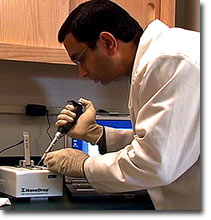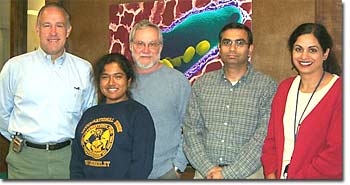New Microarray Center will boost Lab's DNA and protein research
LIVERMORE, Calif. - Thanks to the recent flood of genomic research, scientists now have a wealth of new information at their fingertips about the genetic code that determines the physical makeup of all living things.
But knowing the sequence of an organism's DNA is only one step in understanding the role genes play in the organism's growth and development, and its susceptibility to disease and physical defects.
Microarrays, also known as biochips or gene chips, are a powerful new tool that researchers can use to quickly and efficiently determine which genes in a cell are active, or "expressed," under differing conditions, as well as their level of expression and how they interact with each other. And with the official opening of the Lawrence Livermore National Laboratory (LLNL) Microarray Center (LMAC) next week, scientists across the Lab will have on-site access to the latest state-of-the-art microarray equipment to analyze DNA, proteins, and peptides for their research.
"The Laboratory has decided to pull together all of its microarray resources and expertise in a central facility that can be used to serve researchers in the lab environment," said Ted Rigl of LLNL's Biology and Biotechnology Research Program (BBRP), who heads the new center. "We have people from BBRP, NAI (LLNL's Nonproliferation, Arms Control and International Security Directorate) and other directorates working together with this type of technology," Rigl said. "We want to put together a true collaborative effort in microarray research."
Using the LMAC's equipment and expertise in statistical analysis, Lab scientists will be able to analyze and compare the activity of thousands of genes at a time - substantially furthering their research in such areas as how cells respond to radiation exposure, the causes of cancer and other diseases, and the genetic makeup of the bacteria that cause plague and anthrax.
Microarrays are small glass, nylon or silicon slides on which tiny amounts of DNA are spotted or "printed" by robots in a regular pattern. Each spot features short, immobilized DNA segments called oligonucleotides of a given sequence. There are up to 30,000 unique spots per slide, representing hundreds to thousands of different gene sequences.
Fluorescently labeled nucleotide strands representing genes from the cell under study are allowed to bind, or "hybridize," to their matching counterparts that are immobilized on the slide. By measuring the brightness of each fluorescent spot, researchers can determine how much of a specific DNA fragment is present, indicating how active it is in the cell.
BBRP's Emilio Garcia, a microbiologist who has been studying Yersinia pestis , the plague bacterium, said the LMAC could help his group determine how a host organism's gene activity changes when it is infected with plague. Another researcher, Sharon Messenger of BBRP's Biodefense Division, said microarray technologies could further the development of rapid diagnostic techniques for biodetection and forensics.
"Having a microarray center on-site at Lawrence Livermore will be a real asset for this research," Messenger said.
Another application of microarray technology is for the study of proteins. Julio Camarero of the BioSecurity and Nanosciences Laboratory in LLNL's Chemistry and Materials Science Directorate is collaborating with Matt Coleman of BBRP to study protein-protein and protein-DNA interactions using protein arrays, and to isolate proteins of interest without time-consuming sample purification.
The LMAC sports a wide range of state-of-the-art equipment, including a high-speed, high-performance printer that can print DNA, protein, and peptide microarrays; a complete Affymetrix GeneChip microarray system for processing, scanning, and analyzing commercial, preprinted slides; and a laser scanner that provides one- to four-color detection simultaneously.
The center's staff will hold an open house from 10:00 to 11:30 AM next Tuesday, Dec. 7, beginning with a short presentation in the Bldg. 361 Auditorium. Representatives from such companies as Affymetrix, Beckman Coulter, Perkin Elmer, and Qiagen will be available at the center, located in Bldg. 364, to discuss their equipment. More information on the center is available on the BBRP Website at http://microarray.llnl.gov/ .
Founded in 1952, Lawrence Livermore National Laboratory is a national security laboratory, with a mission to ensure national security and apply science and technology to the important issues of our time. Lawrence Livermore National Laboratory is managed by the University of California for the U.S. Department of Energy's National Nuclear Security Administration.
Contact
Charlie Osolin[email protected]
925-422-8367
Related Links
LLNL Microarray Collaboration Group"DNA Microarray Technology"







